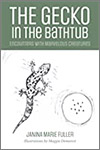Review — THE GECKO IN THE BATHTUB by Janina Fuller (Philippines)
The Gecko in the Bathtub: Encounters with Marvelous Creatures
by Janina Marie Fuller (Philippines 1978-80)
with illustrations by Maggie Demorest
Peace Corps Writers
June 2022
178 pages
$17.50 (paperback)
Reviewed by Andy Amster (Philippines 1978-80)
•

Janina Fuller
The Gecko in the Bathtub, Janina Fuller’s collection of stories about her interactions with a wide variety of animals, in settings both mundane and exotic, is subtitled Encounters with Marvelous Creatures. And I must say that while reading these stories, I came to realize that I was having an encounter with a marvelous writer, one whose love of nature and respect for its ecosystems and their inhabitants artfully enlists the reader into “allyship” in that love and respect.
From the moment I glanced at the “Table of Contents” before settling down to read this wonderful book, I knew I was putting myself in the hands of an assured and engaging writer. “So Much Alaska,” “Visit from a Raptor,” “The Day I was a Tree,” “Making Peace with Cats,” “In the Company of an Alligator,” and of course the title story “The Gecko in the Bathtub” — these are just a few of the titles that reflect Dr. Fuller’s light-hearted approach to sharing her stories.
Although the stories are short — typically three or four pages in length — they are anything but “simple.” They take place in a variety of settings, including the Indiana of Dr. Fuller’s childhood, the Oregon of her college years and young adulthood, the Galápagos Islands and Amazon jungle during visits to her marine biologist son, and rural Louisiana, where she lived during her graduate education and doctoral work. She employs a variety of techniques, including evocations of popular culture, to enliven the narrative and avoid the pedantic. “A hoatzin is a robust, pheasant-sized bird that looks like a cross between a turkey and Blue Man Group.” “Robbie’s first thought [in encountering a 12-foot Galápagos shark] was of Luke Skywalker’s battle with Jabba’s rancor in Return of the Jedi.” An armadillo “looks like a football with feet.”
One wouldn’t necessarily expect a history lesson in a book of stories focusing on one woman’s encounters with marvelous creatures, but in Part 4 of the story “In the Company of an Alligator,” Dr. Fuller relates the fascinating story behind the creation of what would become the National Audubon Society, and the eventual passage of the Migratory Bird Treaty Act of 1920, which to this day continues to protect migratory birds native to North America. It’s a highly satisfying tale of decency overcoming vanity and careless commerce.
To say Dr. Fuller is a born naturalist is an understatement. To the ears of many twenty-first century biologists, the word “naturalist” must seem almost quaint, evoking images of Darwin and Spencer, rather than Watson and Crick (and their successors). It’s easy to be seduced by high-tech gadgetry, but it can represent a lost opportunity to understand and engage in the fascinating world of “marvelous creatures” that Dr. Fuller presents to us – a world that requires no specialized and expensive apparatus such as electron microscopes, or gel electrophoresis, or restriction enzymes, or cloning tools, or DNA sequencers. Hers is a world that requires at most a pair of binoculars, along with curiosity, eyes and ears, and patience. Her book is a joy to read, and an inspiration to all of us who want to learn more about the fellow animals with whom we share the earth.
•

Andy Amster
Reviewer Andy Amster was born and raised in Los Angeles, California. Undergraduate education at Pomona College, Claremont, California majoring in (biology). Following that he served two years in the Peace Corps/Philippines. Graduate education in tropical/infectious disease epidemiology at the UCLA School of Public Health. Post graduate work experience includes two years as staff epidemiologist at the End Stage Renal Disease Network Coordinating Council and 35 years as Senior Director at the Center for Healthcare Analytics, Kaiser Permanente, leading a team whose work centered around the measurement, analysis, evaluation, and improvement of the quality of health care nationally.

No comments yet.
Add your comment